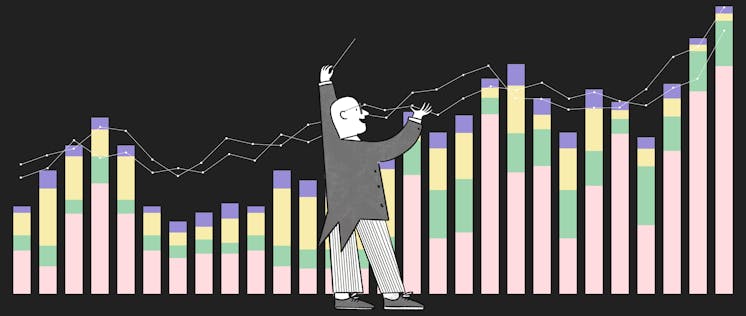
Petty cash imprest system: streamlining your daily cash management for 2024
Many of us think there's no point dealing in wads of notes or the jingling coins in your pocket because vendors simply won't accept cash. But even after 2020 (the year that cash was supposedly wiped out for good), cash payments actually rose by 400 million in 2022. For a so-called cashless society, that's a heck of a lot.
If your business still deals in cash, it’s important to manage it correctly. As well as general income and expenses, this includes your petty cash system. Because without proper management, petty cash can leak funds from quarter to quarter.
Luckily, there’s the imprest system.
A lean and efficient way to manage your small expenses, this system can transform your cash budgeting from static to dynamic.
Content
What’s the imprest system of petty cash?
There are several different ways to manage a petty cash fund, but the imprest system is generally regarded as the most efficient accounting method. The basic function of an imprest system is reserving a fixed amount that will be replenished after being spent.
The imprest system of petty cash uses documentation, such as petty cash vouchers and receipts, to determine how much the fund must be topped up by to reach its original amount.
Let’s imagine there’s £100 in the fund at the beginning of the month. If £75 is spent during the next thirty days, the receipts must equal £75 and this amount will be returned from the general accounts to the petty cash account at the start of the following month.
How does an imprest account work?
An imprest system has two main parts:
- Employees are credited with the amount they spent on petty cash expenses after providing a receipt
- The entire fund is topped up to its original amount at the end of a given period
Here’s a breakdown of how an imprest account could work:
- The petty cash box is filled up with a specific amount, let’s say: £100
- Each time someone in the business incurs a petty cash expense, they bring the receipt or invoice to the petty cashier
- Once approved, expenses are debited from the petty cash jar and credited to the employee who incurred the expense of £10 (following along so far?)
- The receipt for the original purchase, alongside other documentation, forms a petty cash voucher and is then recorded in the imprest petty cash book
- At the end of the accounting period (usually once per month), the petty cash fund gets that £10 back, so it's at the starting amount again, from the general company expenses pot. The amount given to the imprest petty cash fund should equal the amount spent during the month, and match the total value of the receipts
- The amount used to top-up the petty cash jar back to its original amount (in this example £10) is recorded in the general ledger as petty cash expenses
Types of imprest accounts
Before we dive into the features of an imprest system, you should know that there are two different types of imprest accounts – standing imprest and special advance.
With standing imprest accounts, an employee makes a purchase with their own money and then asks for reimbursement from the petty cash fund when they present a receipt.
Alternatively, a special advance account allows an employee to get the petty cash before the purchase, so they don’t have to dip into their own pockets.
Features of the imprest system
Two key features of an imprest account separate it from the standard open or fixed petty cash systems:
- Limited total allocation
- Working retrospectively OR proactively
Limited total allocation
The main feature of an imprest system is that it always has a maximum amount that you can never go over, which means it can’t accumulate money.
In open and fixed petty cash systems, there’s the risk of running out of cash or allocating too many resources to the petty cash fund.
But with evidence-based replenishment (as documented by the receipts in an imprest system), these issues are not present. Phew!
What’s more, expenses are periodically recognised when the petty cash custodian (aka the person put in charge of the petty cash jar) documents everything, making it relatively easy to spot and investigate any discrepancies.
Retrospective vs prospective nature
A standing imprest system that works retrospectively, in that your employee has already made the purchase by the time they come to your petty cash custodian to request reimbursement.
But working prospectively, a special advance requires your people to request the petty cash funds before they have paid out for an expense. Essentially skipping the middle-man and simply using the company funds to pay for small expenses.
This feature is useful as you can decide what method of working is the best for your situation. Plus, there are automated expense systems available for other types of spending, but despite this, cash is usually kept manual with a petty cash log book.
What are the benefits of using the imprest system?
The imprest management is widely regarded as the best form of petty cash system.
Since every single purchase is required to be documented, it’s much harder for unauthorised purchases to fall through the cracks.
No unauthorised purchases
When compared to an open system, the petty cash custodian is granted an amount with no spending period. Once this is spent (no matter how quickly), the petty cash custodian will request more from the general expenses account. This is considered a poor way to work compared to an imprest system since it doesn't encourage the conservation of spending.
Without guidelines, people are more likely to spend on unnecessary and unauthorised purchases, which the documentation of an imprest system works to prevent.
Leaner cash management
A fixed system of petty cash can lead to extra money being allocated to the petty cash fund that simply never gets spent. And guess what? You don’t get that problem with imprest management.
The fixed petty cash system means there’s a fixed period to spend the money over, and then the fund is always given back the same amount, even if the full amount wasn’t spent. It’s tricky, because it means the petty cash fund can accumulate.
This can skew budgeting and affect working cash flow, whereas an imprest system is a leaner way to work (while still being efficient) as it gives only what you need and nothing more.
More dynamic budgeting
Another reason that the imprest system in accounting is generally preferred is that it works with double documentation, meaning the total amount can be changed based on historical spending patterns. This means that more or less can be allocated to the petty cash fund based on spending each month – making bookkeeping easier.
Because the petty cash custodian is required to record all receipts and cash advances in the imprest petty cash book, it’s easier to spot discrepancies and avoid duplicate entries.
What to watch out for with the imprest system
The major concern for any petty cash system is leakage; the small, controllable losses of money. No matter whether your company uses an imprest account entry, either open or fixed, a poorly trained petty cash custodian is likely to make mistakes. And if the system isn’t well-oiled, then there’s a chance that some people could take advantage with unapproved spending.
Another key concern when using a standard imprest system is that the only way to control spending is after the money is already spent. This may leave businesses in a sticky situation, either reimbursing staff for unauthorised purchases or turning requests away. Many instances of the latter may lead to lower workplace satisfaction, decreased productivity and contribute to a higher employee turnover rate.
What does the future of the imprest system hold?
These days, petty cash systems are becoming less and less common as people make way for credit cards and digital payment systems. For some companies, it’s a no-brainer when there’s no paperwork required, less time spent in accounting and no account replenishment.
Smart company cards make spending easier to control, especially when spending limits can be set and adjusted accordingly.
Maybe you’re ready for a change?
Pleo’s petty cash software simplifies how you log cash purchases and gets your team reimbursed whenever they spend with cash.
Plus, admins get access to a dashboard where they see what’s owed to who, along with all the other business spending too, like mileage reimbursement.
So, the next time you need to log a fancy £9.99 supermarket trifle for the next office birthday, digital petty cash management will turn that trifle into a piece of cake.

Smarter spending for your business
Save time on tedious admin and make smarter business decisions for the future. Join Pleo today.
Powered in the UK by B4B partnership
You might enjoy...

Petty cash vouchers are essential in 2024 and here’s why
Still using cash for business expenses in 2024? Documentation can be tricky … say hello to the petty cash voucher.

How Pleo’s spend controls can help you create business spending symphony
Rather than feeling out of control, how about relying on a system that gives you efficient workflows and a detailed view of every expense?

How to choose your petty cash custodian
What do a librarian and a petty cash custodian have in common?
